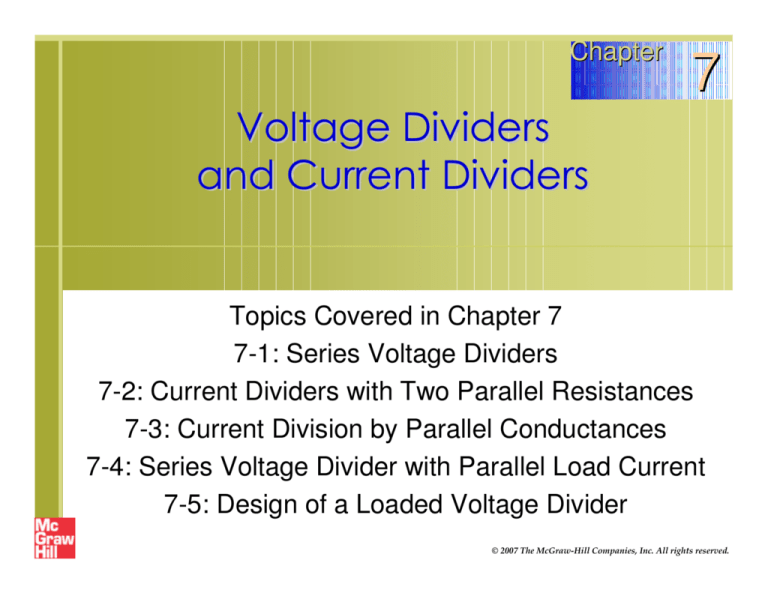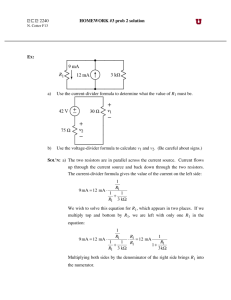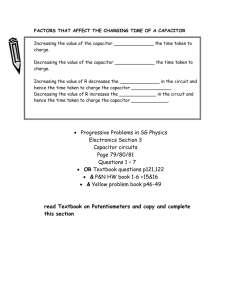
Chapter
7
Voltage Dividers
and Current Dividers
Topics Covered in Chapter 7
7-1: Series Voltage Dividers
7-2: Current Dividers with Two Parallel Resistances
7-3: Current Division by Parallel Conductances
7-4: Series Voltage Divider with Parallel Load Current
7-5: Design of a Loaded Voltage Divider
© 2007 The McGraw-Hill Companies, Inc. All rights reserved.
7-1: Series Voltage Dividers
VT is divided into IR voltage drops that are proportional
to the series resistance values.
Each resistance provides an IR voltage drop equal to its
proportional part of the applied voltage:
VR = (R/RT) × VT
This formula can be used for any number of series
resistances because of the direct proportion between
each voltage drop V and its resistance R.
The largest series R has the largest IR voltage drop.
McGraw-Hill
© 2007 The McGraw-Hill Companies, Inc. All rights reserved.
7-1: Series Voltage Dividers
The Largest Series R Has the Most V.
V1 =
R1
RT
× VT
1 kΩ
=
× 1000 V = 1 V
1000 kΩ
R2
× VT
RT
999 kΩ
× 1000 V = 999 V
=
1000 kΩ
V2 =
KVL check: 1 V + 999 V = 1000 V
Copyright © The McGraw-Hill Companies, Inc. Permission required for reproduction or display.
Fig. 7-2a: Example of a very small R1 in
series with a large R2; V2 is almost
equal to the whole VT.
7-1: Series Voltage Dividers
Voltage Taps in a Series
Voltage Divider
Different voltages are
available at voltage taps
A, B, and C.
The voltage at each tap
point is measured with
respect to ground.
Ground is the reference
point.
Fig. 7-2b: Series voltage divider with voltage taps.
Copyright © The McGraw-Hill Companies, Inc. Permission required for reproduction or display.
7-1: Series Voltage Dividers
Voltage Taps in a Series Voltage Divider
Note: VAG is the sum of the
voltage across R2, R3, and R4.
VAG is one-half of the applied
voltage VT, because R2+R3+
R4 = 50% of RT.
VAG = 12 V
2.5 kΩ
× 24 V = 3 V
VBG =
20 kΩ
1 kΩ
× 24 V = 1.2 V
VCG =
20 kΩ
Copyright © The McGraw-Hill Companies, Inc. Permission required for reproduction or display.
7-2: Current Dividers with
Two Parallel Resistances
IT is divided into individual branch currents.
Each branch current is inversely proportional to the
branch resistance value.
For two resistors,
R2
R1 and R2, in parallel:
I1 =
× IT
R1 + R 2
Note that this formula can only be used for two branch
resistances.
The largest current flows in the branch that has the
smallest R.
7-2: Current Dividers with
Two Parallel Resistances
Current Divider
I1 = 4 Ω/(2 Ω + 4 Ω) × 30A = 20A
I2= 2 Ω /(2 Ω + 4 Ω) × 30A = 10A
Fig. 7-3: Current divider with two branch
resistances. Each branch I is inversely
proportional to its R. The smaller R has
more I.
Copyright © The McGraw-Hill Companies, Inc. Permission required for reproduction or display.
7-3: Current Division by
Parallel Conductances
For any number of parallel branches, IT is divided into
currents that are proportional to the conductance of the
branches.
For a branch having conductance G:
G
I=
GT
× IT
7-3: Current Division by
Parallel Conductances
G1 = 1/R1 = 1/10 Ω = 0.1 S
G2 = 1/R2 = 1/2 Ω = 0.5 S
G3 = 1/R3 = 1/5 Ω = 0.2 S
Fig. 7-5: Current divider with branch conductances G1, G2, and G3, each equal to 1/R. Note that
S is the siemens unit for conductance. With conductance values, each branch I is directly
proportional to the branch G.
Copyright © The McGraw-Hill Companies, Inc. Permission required for reproduction or display.
7-3: Current Division by
Parallel Conductances
The Siemens (S) unit is the reciprocal of the ohm (Ω)
GT = G1 + G2 + G3
= 0.1 + 0.5 + 0.2
GT = 0.8 S
I1 = 0.1/0.8 x 40 mA = 5 mA
I2 = 0.5/0.8 x 40 mA = 25 mA
I3 = 0.2/0.8 x 40 mA = 10 mA
KCL check: 5 mA + 25 mA + 10 mA = 40 mA = IT
7-4: Series Voltage Divider with
Parallel Load Current
Voltage dividers are often used to tap off part of the
applied voltage for a load that needs less than the total
voltage.
Fig. 7-6: Effect of a parallel load in part of a series voltage divider. (a) R1 and R2 in series without
any branch current. (b) Reduced voltage across R2 and its parallel load RL. (c) Equivalent circuit
of the loaded voltage divider.
Copyright © The McGraw-Hill Companies, Inc. Permission required for reproduction or display.
7-4: Series Voltage Divider with
Parallel Load Current
V1 = 40/60 x 60 V = 40 V
V2 = 20/60 x 60 V = 20 V
V1 + V2 = VT = 60 V
(Applied Voltage)
Fig 7-6
7-4: Series Voltage Divider with
Parallel Load Current
The current that passes through all the resistances in the voltage
divider is called the bleeder current, IB.
Resistance RL has just its load current IL.
Resistance R2 has only the bleeder current IB.
Resistance R1 has
both IL and IB.
Fig. 7-6
7-5: Design of a
Loaded Voltage Divider
Fig. 7-7: Voltage divider for different voltages and currents from the source VT.
Copyright © The McGraw-Hill Companies, Inc. Permission required for reproduction or display.
7-5: Design of a
Loaded Voltage Divider
I1 through R1 equals 30 mA
I2 through R2 is 36 + 30 = 66 mA
I3 through R3 is 54 + 36 + 30 = 120 mA
V1 is 18 V to ground
V2 is 40 − 18 = 22 V
V3 is 100 V (Point D) − 40 = 60 V
7-5: Design of a
Loaded Voltage Divider
R1 = V1/I1 = 18 V/30 mA = 0.6 kΩ = 600 Ω
R2 = V2/I2 = 22 V/66 mA = 0.333 kΩ = 333 Ω
R3 = V3/I3 = 60 V/120 mA = 0.5 kΩ = 500 Ω
NOTE: When these values are used for R1, R2, and R3 and
connected in a voltage divider across a source of 100 V,
each load will have the specified voltage at its rated current.






